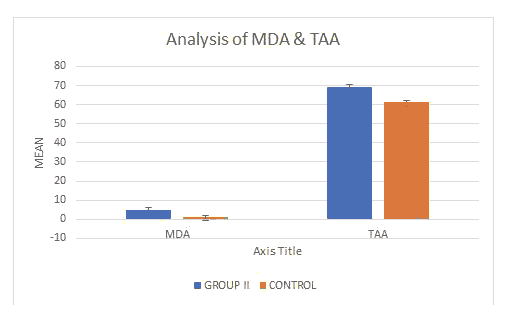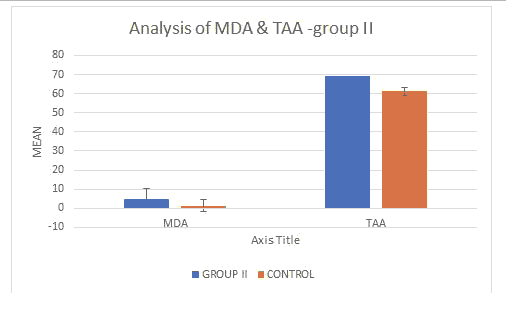Short Communication - (2021) Volume 9, Issue 12
Evaluation of Oxidative Stress in Radiology Unit Workers
*Correspondence: M. Vijayamalathi, Sree Balaji Medical College & Hospital Affiliated to Bharath Institute of Higher Education and Resea, Chennai, Tamil Nadu, India, Email:
Abstract
The present study showed a significant increase in oxidant levels in radiographers exposed to ionising radiation. A linear relationship was observed between oxidant level and years of exposure.An increase in total antioxidant activity in group-I was observed and this is essentially an adaptive response to ionising radiation exposure. But with increase in years of exposure to low dose ionising radiation the antioxidants are found to be used up leading to a slightly reduced level in group- II.A positive _correlation was also noticed between the levels of oxidants and antioxidants of exposed and unexposed groups.The estimation of oxidant and antioxidant status is hence a useful indicator, as redox imbalance is an immediate consequence of any biological damage caused by ionising radiation.Keywords
Ionizing Radiation, Redox, ExposureIntroduction
Radiation is a process, which is proves to affect many parts of the body. the extent of damage can only be ascertained only by knowing the absorbed level of radiation. These radiations can cause tissue damage, induce chemical changes also cause molecular damage. This biological damage is evident at much later stages. The cells when exposed to radiation causes oxidative stress which induces the cells to increase the antioxidant levels [1-2]. An antioxidant is a molecule which will donate an electron a damaging free radical and neutralize it. To ensure the level of radiation received by radiation professionals is within acceptable limits, the Maximum permissible dose (MPD) is used as the standard [3]. Hence this study is to analyze the oxidative stress status in radiology unit workers who are exposed to persistent low dose ionizing radiation.
Methodology
This study consist of 39 volunteers and they were categories in to two groups ,group I were exposed to low dose of ionizing radiation working in X RAY unit and group II were exposed to 10msmg radiation, working in x-ray units. They were exposed for almost 14 years. The blood samples were collected from the volunteers and analyzed for oxidant and anti-oxidant levels.
Results
The mean serum oxidant malondialdehyde (MDA) and Total antioxidant (TAA) level were observed is4.05±1.65 in test groups was higher than the mean MDA level of 1.47±0.72 in controls. The P value is less than 0.05 and the results are statistically significant (Fig:1). The mean serum MD level of 4.97±1.39 in test groups -II was higher than the mean MDA-level of 1.47±0.72 in controls. The P value is less than 0.05 and the results are statistically significant.The mean serum total antioxidant activity in test groups of 69.3±3.03 was higher than the mean serum total antioxidant activity of 61.2±2.04 in controls. The P value is less than 0.05 and the results are statistically significant (Fig:2)

Figure 1: Analysis of MDA & TAA.

Figure 2: Analysis of MDA & TAA Group II.
Discussion
In the present study, a slight increase in MDA levels was noted in radiographers exposed to ionising radiation for a period of 7 to 14 years as compared to those exposed for less than 7 years. This indicates the presence of an additive dose as explained by linear no threshold model (lnt). generally there will be a balance between free radicals and antioxidants but this balance is disturbed in individual exposed in radiology units [4]. From the study its evident that slight decrease in antioxidant level in workers exposed for 7 to 14 years as compared to workers exposed to less than 7 years. This could be the result of reduced antioxidant defense activity as the antioxidants are used up to combat oxidative stress occurring over prolonged periods. This ultimately leads to an imbalance in oxidant and antioxidant status [5].
References
- Billen, Daniel. "Spontaneous DNA damage and its significance for the" negligible dose" controversy in radiation protection." Radiat Res 124, (1990): 242-245.
- Ward, J. F. "Response to commentary by D. Billen." Rad Res126, (1991): 385-387
- Cardis, Elisabeth, Vrijheid M, Blettner M, and Gilbert E, et al. "Risk of cancer after low doses of ionising radiation: retrospective cohort study in 15 countries." BMJ 331, (2005): 77.
- Billen, Daniel. "Spontaneous DNA damage and its significance for the" negligible dose" controversy in radiation protection." Radiation research 124, (1990): 242-245.
- Joiner, MC. "Induced radioresistance: an overview and historical perspective." International Journal of Radiation Biology 65, (1994): 79-84.
Author Info
Sree Balaji Medical College & Hospital Affiliated to Bharath Institute of Higher Education and Resea, Chennai, Tamil Nadu, IndiaCitation: M. VijayamalathiEvaluation of Oxidative Stress in Radiology Unit Workers, J Res Med Dent Sci, 2021, 9(11): 1-2
Received: 01-Dec-2021 Accepted: 15-Dec-2021 Published: 22-Dec-2021
